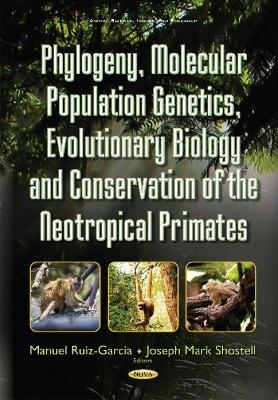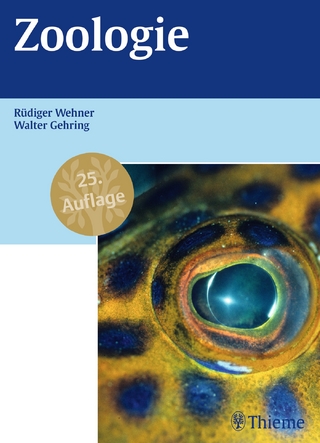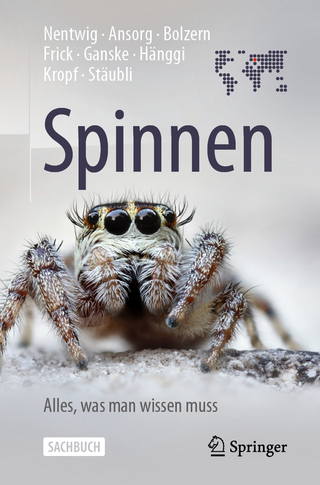
Phylogeny, Molecular Population Genetics, Evolutionary Biology & Conservation of the Neotropical Primates
Nova Science Publishers Inc (Verlag)
978-1-63485-165-7 (ISBN)
Unfortunately, a large percentage of Neotropical primate species are threatened or endangered due to various anthropogenic activities including deforestation, illegal hunting, illegal wildlife trade, mining, and road construction. Moreover, there is a general paucity of data of this group because their habitats can be difficult to access and the sheer expansiveness of the Neotropical area.
In this book, the authors present new research findings from sixty of the world’s leading Neotropical primate scientists in order to bridge this information gap. Specifically, the authors provide up-to-date biological, molecular, conservation, and phylogenic information on many of these poorly understood, yet amazing creatures. It is the authors’ intention that this new information will be used as a resource by the novice and professional alike in order to improve society’s understanding of Neotropical primates and to help protect them long into the future.
Preface
Introduction
Chapter 1. An Introduction to Neotropical Primates
(Joseph M. Shostell and Manuel Ruiz-Garcia, Math, Science, and Technology Department, University of Minnesota Crookston, Crookston, MN, USA, and others)
Phylogeny, Molecular Population Genetics and Paleoprimatology
Chapter 2. The Paleobiology of the Recently-Extinct Platyrrhines of Brazil and the Caribbean
(Siobhán B. Cooke, Justin T. Gladman, Lauren B. Halenar, Zachary S. Klukkert, and Alfred L. Rosenberger, Department of Anthropology, Northeastern Illinois University, Chicago, IL, USA, and others)
Chapter 3. Genetic Heterogeneity and Evolutionary Demographic History of the Endemic Colombian Saguinus leucopus (Primates) by Means of DNA Microsatellites and Coalescence Methods
(Manuel Ruiz-García, Pablo Escobar-Armel, Norberto Leguizamón, and Joseph Mark Shostell, Laboratorio de Genética de Poblaciones-Biología Evolutiva. Unidad de Genética. Departamento de Biología. Facultad de Ciencias. Pontificia Universidad Javeriana. Bogotá DC, Colombia, and others)
Chapter 4. Diversity of Cebus Species from the Southern Distribution of the Genus
(Mariela Nieves and Marta Dolores Mudry, Grupo de Investigación en Biología Evolutiva, Departamento de Ecología, Genética y Evolución, Facultad de Ciencias Exactas y Naturales, Universidad de Buenos Aires, IEGEBA (CONICET-UBA), Ciudad Universitaria, Buenos Aires, Argentina, and others)
Chapter 5. Genetic Structure, Spatial Patterns and Historical Demographic Evolution of White-Throated Capuchin (Cebus capucinus, Cebidae, Primates) Populations of Colombia and Central America by Means of DNA Microsatellites
(Manuel Ruiz-García and María Ignacia Castillo, Laboratorio de Genética de Poblaciones-Biología Evolutiva. Unidad de Genética. Departamento de Biología. Facultad de Ciencias. Pontificia Universidad Javeriana. Bogotá DC., Colombia)
Chapter 6. Invalidation of Three Robust Capuchin Species (Cebus libidinosus pallidus, C. macrocephalus and C. fatuellus; Cebidae, Primates) in the Western Amazon and Orinoco by Analyzing DNA Microsatellites
(Manuel Ruiz-García, María Ignacia Castillo, Kelly Luengas-Villamil, and Norberto Leguizamón, Laboratorio de Genética de Poblaciones-Biología Evolutiva. Unidad de Genética. Departamento de Biología. Facultad de Ciencias. Pontificia Universidad Javeriana. Bogotá DC., Colombia, and others)
Chapter 7. It is Misleading to use Sapajus (Robust Capuchins) as a Genus? A Review of the Evolution of the Capuchins and Suggestions on their Systematics
(Manuel Ruiz-García, María Ignacia Castillo and Kelly Luengas-Villamil, Laboratorio de Genética de Poblaciones-Biología Evolutiva. Unidad de Genética. Departamento de Biología. Facultad de Ciencias. Pontificia Universidad Javeriana. Bogotá DC., Colombia)
Chapter 8. Sex Chromosomes and Sex Determination in Platyrrhini
(Steinberg, E.R. and Mudry, Grupo de Investigación en Biología Evolutiva (GIBE) –Departamento de Ecología, Genética y Evolución – Facultad de Ciencias Exactas y Naturales – Universidad de Buenos Aires - Ciudad Universitaria – Buenos Aires – Argentina, and others)
Chapter 9. Can Mitochondrial DNA, Nuclear Microsatellite DNA and Cranial Morphometrics Accurately Discriminate Different Aotus Species (Cebidae)? Some Insights on Population Genetics Parameters and the Phylogeny of the Night Monkeys
(Manuel Ruiz-García, Adriana Vallejo, Emily Camargo, Diana Alvarez, Norberto Leguizamon, and Hugo Gálvez, Laboratorio de Genética de Poblaciones-Biología Evolutiva. Unidad de Genética. Departamento de Biología. Facultad de Ciencias. Pontificia Universidad Javeriana. Bogotá DC., Colombia, and others)
Chapter 10. Phylogenetic relationships of Pithecidae and Temporal Splits in Reference to Cebidae and Atelidae by Means of Mitogenomics
(Manuel Ruiz-García, Geven Rodríguez, Myreya Pinedo-Castro, and Joseph Mark Shostell, Laboratorio de Genética de Poblaciones-Biología Evolutiva. Unidad de Genética. Departamento de Biología. Facultad de Ciencias. Pontificia Universidad Javeriana. Bogotá DC., Colombia, and others)
Chapter 11. Microsatellite DNA Analyses of Four Alouatta Species (Atelidae, Primates): Evolutionary Microsatellite Dynamics
(Manuel Ruiz-García, Pablo Escobar-Armel, Marta Mudry, Marina Ascunce, Gustavo Gutierrez-Espeleta, and Joseph Mark Shostell, Unidad de Genética (grupo de Genética de Poblaciones-Biología Evolutiva). Departamento de Biología. Facultad de Ciencias. Pontificia Universidad Javeriana. Bogotá DC., Colombia, and others)
Chapter 12. Which Howler Monkey (Alouatta, Atelidae, Primates) Taxa is Living in the Peruvian Madre de Dios River Basin (Southern Peru)? Results from Mitochondrial Gene Analyses and some Insights in the Phylogeny of Alouatta
(Manuel Ruiz-García, Angela Cerón, Myreya Pinedo-Castro, and Gustavo Gutierrez-Espeleta, Laboratorio de Genética de Poblaciones-Biología Evolutiva. Unidad de Genética. Departamento de Biología. Facultad de Ciencias. Pontificia Universidad Javeriana. Bogotá DC., Colombia, and others)
Chapter 13. Historical Genetic Demography and some Insights into the Systematics of Ateles (Atelidae, Primates) by Means of Diverse Mitochondrial Genes
(Manuel Ruiz-García, Angela Cerón, Myreya Pinedo-Castro, and Gustavo Gutierrez-Espeleta, Laboratorio de Genética de Poblaciones-Biología Evolutiva. Unidad de Genética. Departamento de Biología. Facultad de Ciencias. Pontificia Universidad Javeriana. Bogotá DC., Colombia, and others)
Conservation Biology
Chapter 14. Capuchin Monkeys in Amazonian Mangrove Areas
(R. R. Santos, R. G. Ferreira, A. Araujo, Center for Agrarian and Environmental Sciences, Federal University of Maranhão, Brazil, and others)
Chapter 15. How does the Colombian Squirrel Monkey Cope with Habitat Fragmentation? Strategies to Survive in Small Fragments
(Xyomara Carretero-Pinzon, Thomas R Defler and Manuel Ruiz-Garcia, Laboratorio de Genética de Poblaciones-Biología Evolutiva. Unidad de Genética. Departamento de Biología. Facultad de Ciencias. Pontificia Universidad Javeriana. Bogotá DC., Colombia, and others)
Chapter 16. Callicebus ornatus, an Endemic Colombian Species: Demography, Behavior and Conservation
(Xyomara Carretero-Pinzon and Thomas R Defler, University of Queensland, School of Geography, Planning and Environmental Management, Brisbane, Australia, and others)
Chapter 17. Biogeography and Conservation of the Pitheciines: Sakis, Bearded Sakis and Uacaris (Pithecia, Chiropotes and Cacajao)
(Marilyn A. Norconk and Sarah Boyle, Department of Anthropology, Kent State University, Kent OH, USA, and others)
Chapter 18. State of Primates in Northeastern Peru: The Case of the Pacaya-Samiria National Reserve
(Pablo Puertas, R. Bodmer and Miguel Antúnez, Fundación Latinoamericana para el Trópico Amazónico (FundAmazonia) - Center for International Forestry Research (CIFOR), and others)
Chapter 19. Current Knowledge on Primate Distribution and Conservation in Bolivia
(Heidy Lopez-Strauss, Robert B. Wallace, Nohelia Mercado, and Zulia R. Porcel, Wildlife Conservation Society, La Paz, Bolivia, and others)
| Erscheinungsdatum | 13.05.2016 |
|---|---|
| Verlagsort | New York |
| Sprache | englisch |
| Maße | 180 x 260 mm |
| Gewicht | 1336 g |
| Themenwelt | Naturwissenschaften ► Biologie ► Zoologie |
| ISBN-10 | 1-63485-165-X / 163485165X |
| ISBN-13 | 978-1-63485-165-7 / 9781634851657 |
| Zustand | Neuware |
| Haben Sie eine Frage zum Produkt? |
aus dem Bereich


